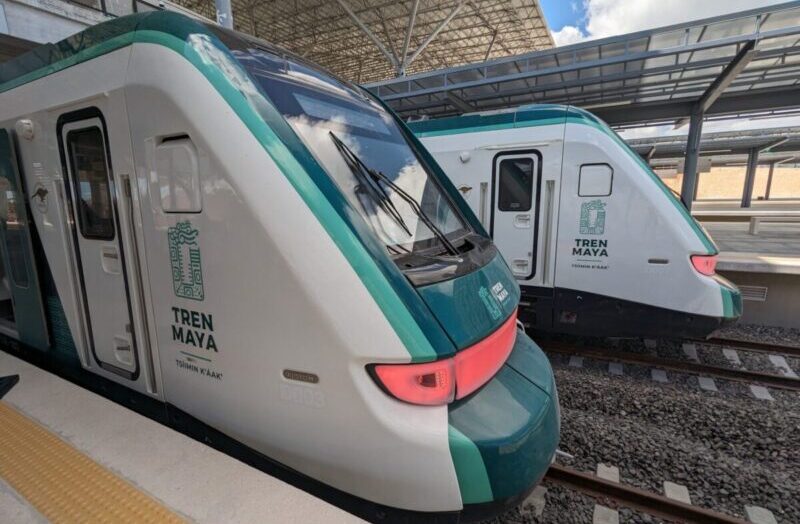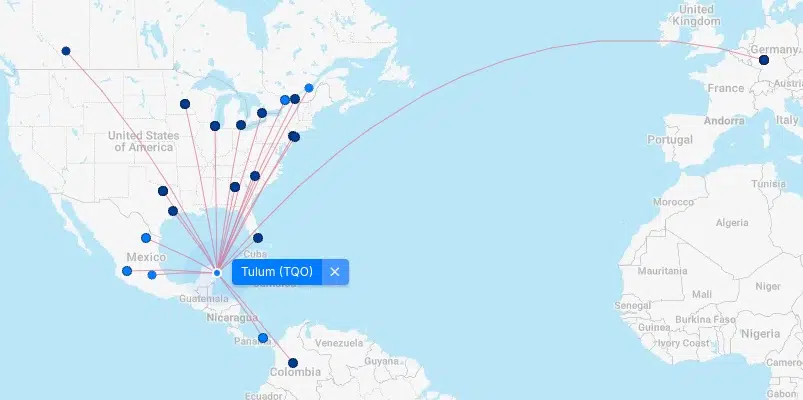Tulum was once a laid back beach town surrounded by nothing but jungle, cenotes, and the famed Mayan ruins. But the times, they are a-changin’.
After years of chatter, the new Tulum (TQO) airport officially opened to travelers in late 2023 just over a year after construction first began – a truly staggering feat. Today, this beachside paradise is more popular (and easier to get to) than ever. It just took a while for word of the new airport to get out.
Within weeks of opening up to international flights from U.S. airlines, I headed down for a firsthand look and found a beautiful new airport … that seemingly no one knew about. But after a return trip earlier this month, it’s safe to say the secret is out: The Tulum airport is fully open for business – and business is booming.
With a year and change of operations under its belt, travelers are now clearly keen to skip the nearly two-hour drive from Cancún (CUN) in favor of this brand-new airport. And with regular nonstop flights on many major carriers from nearly a dozen U.S. cities – plus a handful of other international markets – who can blame them?
Read on for a closer look at what’s happening down in Tulum.
What Airlines Fly to Tulum?
Here’s a quick look at all the ways to fly nonstop to Tulum as of publication in February 2025.
- Delta was the first to put Tulum on the map with daily nonstop service from its Atlanta (ATL) hub – later adding seasonal service from both Detroit (DTW) and Minneapolis-St. Paul (MSP)
- American Airlines was equally quick to add service to Tulum, flying from its hubs in Charlotte (CLT), Dallas-Fort Worth (DFW), and Miami (MIA)
- United Airlines operates nonstop service from Chicago-O’Hare (ORD), Houston-Intercontinental (IAH), and Newark (EWR)
- JetBlue flies there from New York City (JFK)
- For Canadians, Air Canada, West Jet, and a few low-cost carriers serve Tulum from Toronto (YYZ), Montreal (YUL), Calgary (YYC), Ottawa (YOW, and Quebec City (YQB)
- Discover Airlines – a leisure-oriented offshoot of German flag carrier, Lufthansa – offers seasonal nonstop service to Tulum from Frankfurt (FRA)
- Copa Airlines flies to Tulum from Panama City (PTY)
- Avianca flies nonstop to Tulum from Bogota (BOG)
- Tulum Airport (TQO) is also served domestically by Aeromexico and low-cost-carriers Viva Aerobus, Volaris, and Mexicana from a handful of Mexican cities
Below you can see all the currently announced nonstop flights to Tulum, although not all are operating yet.

In just over a year since opening, we’ve seen several airlines add, reduce, and cancel flights to and from Tulum. It’s clear they’re all trying to find the right balance of supply versus demand.
But if my recent visit was any indication, demand only appears to be growing. I wouldn’t be surprised to see frequencies increase next winter, with more budget carriers looking to fly to Tulum, too.
Getting To and From the Airport
Let’s get one thing clear: Just because it’s called the Tulum Airport, don’t expect to walk off the plane and put your toes in the sand.
It’s the third major airport in the region, after Cancún and Cozumel (CZM) – and while it’s the closest to Tulum by far, it’s still a solid 40-minute drive to town and the main hotel zone.

If you’re heading further north to a hotel like Conrad Tulum or the beach town of Akumal, be prepared for a longer, hour(ish) car ride. The Maya Train is intended to facilitate quicker travel to Tulum proper and even the Playa del Carmen area, but even so, travelers should budget a little extra time getting to and from the airport.
While taking a taxi will be the quickest choice for getting around, it’s not the only one. Here’s a look at the current transportation options to and from the Tulum airport.
Taxi
Let’s start with the easy one. Several taxi providers operate out of the new Tulum airport and charge similar (read as: relatively expensive) prices.
If you’re heading to central Tulum, you can expect to around $50 for the cab ride from the airport. I used “Jungle Shuttle” taxi service for my ride into town and paid approximately $45 before tip for the ride into town. Resorts further north of Tulum will cost you closer to $10. You can safely expect to pay $120 or more if you’re going all the way up to Playa del Carmen.

My taxi ride back to the airport was a little pricier. The driver initially quoted me $75 for the one-way ride, but I was able to negotiate a price closer to $60, with a 5% up-charge for using a credit card. The reason for the higher price is that taxis in town aren’t allowed (or supposed to) pick passengers up from the Tulum airport, meaning they’re most likely driving back without a fare-paying customer.
Depending on traffic, I’d budget approximately 45 minutes for travel between the airport and central Tulum. My taxi driver treated the newly paved stretch of road from the highway to the airport like it was the Autobahn so your experience may vary.
Rental Car
Multiple rental car agencies are open for business at the new Tulum airport, with Hertz being the most well-known brand. Europcar and Mex Rent a Car were the other options I recognized.

In an example search, I found that economy rentals start at around $33 per day. Renting a car might be cheaper than taking a taxi or shuttle, but you’ll likely be on the hook for additional parking charges at your resort so keep that in mind. Be sure to do the math before committing to a rental.
Related reading: Our Complete Guide to Hertz President’s Circle Status
ADO Bus
For those looking to skip the high-priced taxi, ADO Bus is a solid option for getting to Tulum and beyond. They operate routine service to central Tulum, as well as up to Playa del Carmen.

Here is the time table for service to Tulum. The earliest shuttle departs the airport at 10:20 a.m and the latest at 6 p.m. – all shuttles are scheduled around scheduled flight arrivals and are subject to change. The cost for one-way bus service into Tulum is approximately $11 per person.

For what it’s worth, ADO operates really nice, modern motor-coach buses so the ride should be a comfortable one. But for most travelers, taking the bus would likely mean also paying for a short taxi ride or walking the rest of the way to your hotel.
Maya Train
Perhaps the fastest and most cost-effective option is taking the Maya Train. I had a chance to ride the new train from Cancún International Airport (CUN) down to Playa del Carmen and found it was a very comfortable – but not yet efficient – mode of transportation.
The new station at the Tulum Airport recently opened, giving travelers easy access to Tulum, Playa del Carmen, and beyond. The catch with the train is that most of the stations are outside the main city center so just like taking a shuttle bus, you’ll need a short taxi ride to get you to your final destination.

It’s worth noting that the station isn’t connected directly to the airport and does require a bit of a hike to get to and from – so plan accordingly if you’re carrying lots of luggage. The other downside with the train is that it doesn’t run frequently enough to fit the needs of most travelers.
Here’s to hoping that changes soon, as the ride itself is a fun one.
Read more: What’s It Like Riding Mexico’s Maya Train?
Upon Arrival
Getting off the plane in Tulum, you’ll find a ramp adjacent to each gate that takes you directly down to the ground level and baggage claim. This means you shouldn’t find a mass of people crowding the gate area while you’re trying to get off the plane.
With a brand new terminal, it’s a much snazzier vibe than you get deplaning in Cancún.

This works the same for domestic and international arrivals, with international passengers needing to clear immigration before collecting their belongings. On the way to customs and immigration, you’ll pass through a really cool wood and LED-lit tunnel welcoming you to Tulum.

On the other side of the tunnel is the immigration hall with 18 different border officer desks. The line moved quick for us, despite a full plane and less than half of the desks open.
After you get your passport stamped, you can retrieve your luggage from the baggage carousel and proceed through customs. All told, the immigration process was really simple and quick.

There’s also a duty free shop right next to baggage claim if you want to do a little last-minute tax-free shopping before officially entering the country.

Flying Home from Tulum
When it’s time to head home, it’s quite obvious that things at the airport are brand new. Everything is fresh, from the concrete parking lot to the shiny marble floors inside.
Pulling up, you’ll see a sign for the new airport and a huge Mexican flag. Behind that, there’s a little garden area with walkways and benches for anyone with extra time to kill. You’ll also see a statue of the airport’s namesake: Felipe Carrillo Puerto, a Mexican revolutionary and the former governor of the Yucatán state.


The Tulum airport is simple: There’s only one terminal, and the ground level serves both arriving and departing passengers. There are five doors: Two designated for departures, two for arrivals, and one for shuttle services and bus pickup or drop-off.


There’s also a covered surface-level parking lot for travelers to leave a vehicle while on vacation, but based on the amount of spots (or lack thereof) it’s clear that this airport is designed to serve tourists arriving and departing without a vehicle.
Ground Floor
After setting foot inside, you’ll see all the makings of a typical airport with the arrivals board, retail shops, rental car offices, and other transportation services. But one thing you won’t see is baggage claim – both domestic and international arrivals collect baggage in a secured space before exiting to the main arrivals area.

The ground floor arrivals area is quite large with lots of space and natural light.

Construction is now finished and all the retail and dining outlets are open for business. You’ll see lots of familiar American chains, as well as a few local options.
Need a caffeine fix before or after your flight? They’ve got you covered.

Want to grab a slice of pizza or maybe some fried chicken? No problem.

If you’ve got extra time to kill, there’s also a bar on the ground floor where you can grab a drink, as well as a GOmart convenience store for any snack items you may want to grab.

There’s also another small restaurant with limited seating that serves a few hot items, packaged food, and beer, coffee, and soft drinks. And there’s another convenience store where you can grab a snack or drink and find a spot to sit elsewhere in the airport.


Throughout the airport, you’ll see design touches that give a nod to the local environment. With plenty of greenery (natural and artificial), water, natural light, and wood tones, the new Tulum airport really leans heavily into its jungle roots.

Departing passengers will need to head upstairs to the check-in and security area by taking the escalator or staircase on either end of the terminal. There is also an elevator right in the center of the terminal that leads to the second-level ticketing area.
Check-In & Ticketing
Upstairs, you’ll find more natural light, high ceilings with giant wooden beams, and the same spotless marble floors as downstairs. This is where the check-in and ticketing counters are located for each of the airlines serving Tulum’s new airport.

In total there are 40 different check-in desks, divided up into four separate rows. Both American Airlines and Delta Air Lines have their own bank of ticket counters – and the same goes for Aeromexico and Viva Aerobus.


The domestic check-in counters were on the northwest end of the building, coinciding with the domestic departure gates, while international airlines like Delta and American were located on the southeast end. The terminal isn’t big enough for any of this to make a difference so don’t worry about going up the “wrong” set of stairs as you’ll only need to walk a little further to get where you’re going.
Security
There are two separate security checkpoints, each with two lanes, depending on whether you’re traveling on a domestic or international flight. It’s worth noting for travelers heading back to the U.S., or other international destinations, that there isn’t any extra border control or customs processing on departure.

After showing my passport and boarding pass to one of the security officers I was allowed to scan my ticket and enter the checkpoint through one of the automatic gates.
Laptops and large electronics needed to be removed from luggage before screening, as well as large liquids (like a water bottle). I was also asked to remove all items from my pockets and take off my belt and hat before proceeding through the metal detector.
There’s a small table on the other side of security where travelers can repack their belongings before making their way to the gate area.
Inside the Airport: Seating, Dining & … No Lounge
After getting past security, you’ll see a nice digital departure board with boarding gates and departure times listed. This is also where you’ll find Tulum Duty Free, if you want to do any tax-free shopping before heading home.

Both security checkpoints are right in the center of the terminal, so you can either head left to the domestic gates or right to the international departures. Both sides have similar retail and dining options and other amenities.
You’ll find plenty of seating throughout the terminal, adorned in alternating shades of green. There are lots of plants throughout the airport, adding a touch of life, and the ceilings feature Mayan-inspired wood designs that provide a nice artistic touch to the space. Coupled with the flood of natural light, it’s again evident why it’s dubbed the jungle airport.

The walls of floor-to-ceiling glass windows makes for some nice runway views. If you’ve got extra time to kill, one of these lounge chairs would be a great place to kick back and relax.


With high ceilings and all the natural light, the whole airport feels spacious. This is partially due to the current lack of travelers but even during busy times, I don’t envision the terminal ever feeling crowded.
Dining Options
There are two food courts on either side of security, both of which are full of restaurants and retail shops – a stark contrast to my first visit nearly a year ago. You’ll see more familiar names like Subway, Carl’s Jr., and Burger King, as well as a few local options and international chains like Le Pain Quotidien.
Just be warned that finding an open table during busy times can be tough at the food court by the international gates.

Thrifty Tip: If you’re looking to grab a bite before your flight, head to the left after clearing security for shorter lines and an overall quieter terminal.

In addition to the food courts, there are a couple of bars and nicer sit-down restaurants. If you have more time before departure, this would be my choice.

With so many restaurants you no longer need to worry about arriving hungry … but it could pay to arrive on a full stomach. I grabbed a burger at Carl’s Jr. before my flight home and paid nearly $20 for a single combo meal.
Shopping
If prefer a little retail therapy before heading home, you’ll have several choices.
Tulum Duty Free is front and center right after clearing security. Here, you’ll find all the tax-free staples like tobacco products, perfume, liquor, and makeup. If you’re hoping to bring a taste of Mexico home with you this would be a great place to pick something up, just be sure to declare your purchase upon returning to the U.S.


Then you’ll find a few shops selling handbags, artwork, clothing, and other goods.

You’ll also find a handful of pharmacies or mini-marts sprinkled throughout the terminal selling the usual souvenirs, t-shirts, shot glasses, and magnets.

Many of these stores also sold snacks and some drinks. If you just want a light bite to eat or a drink to take on the plane with you, you can find it here.

Other Amenities: An Outdoor Mezzanine, Play Areas & Spotty Wi-Fi
Aside from dining and shopping, there are a few other options for killing time besides just waiting at the gate.
Just to the left (around the corner) from the security checkpoints you’ll find a staircase and elevator that leads up to the airside mezzanine. This area was still roped off in February 2025. Once open, it should be an awesome spot to watch planes take off and land. If you’re heading home to a cold climate, it could also be your last chance to soak up some of Mexico’s warm weather.

If you’re traveling with kids, there are two play areas on either end of the terminal with padded rubber flooring, slides, and other playground equipment. This looks like a great place to burn off some energy before the long flight home.

Power banks are scattered throughout the terminal for anyone needing to charge up their devices before their flight, though none were near seating. Despite the Wi-Fi signs displayed throughout the airport, I had trouble connecting.
I had a similar problem during my first visit and chalked it up to growing pains, but it seems now like their might be a bigger issue. Perhaps it’s just user error on my part, but if you need internet while at the airport, just know you might have to rely on mobile data.

The airport also features two breastfeeding rooms for traveling families and a non-denominational chapel. Finally, there were two medical service centers throughout the terminal for anyone needing medical treatment, though they didn’t appear to be staffed.
Lounges at the Tulum Airport
Travelers with an ultra-premium credit card in their wallets are likely wondering whether or not there’s a lounge at the new airport. The answer is, maybe one day … but not yet.
When I first visited in April, 2024, there was a sign up that read “Sala VIP / VIP lounge” indicating that a lounge would be occupying that space soon. At the time, it appeared this new lounge would be called The Grand Lounge Elite Salas Club – the same name as several lounges in Mexico City (MEX), all of which are a part of the Priority Pass lounge network.

During my most recent visit in February 2025, though, that dedicated lounge space was still vacant … and the sign above has been completely removed.

It’s anyone’s guess if this means plans for a lounge are off or just on hold, but it wouldn’t be surprising if the operator was scared off by the initial lack of traffic. Given the long lines and packed tables during my most recent visit, I no longer think that’s an issue.
Boarding & Gate Area
The airport has eight boarding gates in total. They’re numbered D1 through D4 and each gate is further divided into A and B gates. D1 and D2 gates primarily serve domestic flights while gates D3 and D4 are reserved for international flights.

Each gate features a large TV monitor behind the desk with all the necessary flight information listed. The automatic gates are equipped with a camera for facial recognition and are set to open after passengers scan their boarding passes.

Facial recognition wasn’t in use for either of my flights and the gate agents checked everyone’s passport before they were allowed to scan a boarding pass and proceed to the jet bridge. This led to quite a back up and crowded gate area during my most recent visit.

Some passengers, myself included, were pulled aside for secondary screening in addition to the passport and boarding pass check.
Bottom Line
When the Tulum airport first opened to international travelers last spring, I headed down to check it out. What I found was a beautiful, but sleepy, airport that was still working out the kinks.
After a return visit in February 2025, it’s anything but sleepy. Construction is now complete and the airport is bustling with travelers. Clearly, word has gotten out that there’s a more convenient way to get to Tulum.







